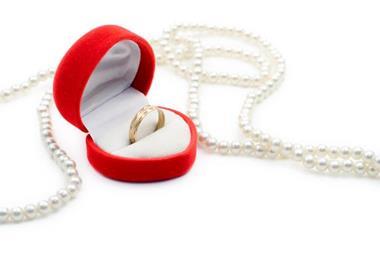Diamonds: the word is enough to make many women swoon. But each stone faces a long and difficult journey before it ends up on the finger of a blushing bride. Kathryn Hopkins looks at how the insurance industry helps make sure that diamonds really are forever ...
They’re only lumps of carbon. But after sitting miles under the earth for millions of years, diamonds are dug up to be transformed into sparkling pieces of jewellery – and that’s when they become vulnerable.
Travelling from the miner to the wholesaler, then to the manufacturer and finally the retailer, the stones become targets for smugglers, corrupt government officials or simply accidental damage – all of which mean insurance is the only way to ensure a diamond really is forever.
“All these sectors have to insure the diamond. They all use a jewellers’ block policy,” says Michael Moss, senior underwriter in global fine art and specie at XL Insurance.
A jewellers’ block policy is an all-risk policy that covers transactions in diamonds, precious stones and jewellery for dealers, retailers and manufacturers. With an all-risk cover, the insurer must state what is not covered. If a risk is not in the list of exclusions, it is covered.
Typical risks include burglary, robbery, shoplifting, mugging, fraud and accidental damage. The most important exclusions are employee dishonesty, damage to goods being worked on and mysterious or unexplained loss. Most other exclusions can be bought back if needed.
Even diamonds haven’t managed to escape the economic downturn, however. Traders have called for a supply cut to help stabilise the industry amid falling prices.
In its latest weekly market report, PolishedPrices said its diamond price index had fallen 7.2% to 127.7 points, after a peak in August. It said this fall was modest compared to some other commodities, but the decline in prices had been accompanied by a big fall in sales volumes.
“Jewellery retailers across the board reported bleak October sales figures this week and warned for difficult times ahead,” the report said. “Although, some in the trade still believe there will be buyers during the all-important Christmas season if there are bargains. De Beers announced it is increasing its advertising campaigns in the run-up to Christmas and heavy discounting by retailers is expected.
“The general sentiment, however, is that the fourth quarter will see sharply reduced demand for diamond jewellery compared to previous years. In the wholesale market, many traders and manufacturers warned that if additional liquidity does not reach the market soon, this will lead to major bankruptcies.”
A report this week from Bloomberg added to the gloom, claiming that diamond prices would report their first annual drop in five years and might fall further next year. This is being blamed on job losses in the US, which makes up almost half of world demand for diamonds. A report published last week by RBC Capital Markets said diamond prices might drop 15% next year.
Diamond prices can fluctuate wildly. Insurance broker Marsh, for example, says that in the August peak, the price of large diamonds increased by an average of 30%, while the price of platinum has almost doubled within 12 months.
Sara Dunn, client executive of private client services at Marsh, says it is the responsibility of policyholders to track such changes and ensure they are adequately covered. She also recommends having jewellery valued every three to five years. “If they do not, in the event of a claim, they will receive no more than the sum insured or the single article limit, leaving them out of pocket,” she says.
In some areas of insurance, such as critical illness policies that list rare diseases, the policyholder knows that the likelihood of having to make a claim is slim to none. But the cost of diamonds – plus all the obstacles that a stone must overcome to make it to a retailer – means that risks rocket. They start at the mine, with the possibility of workers pocketing findings or outsiders wanting to get their cut, particularly in volatile countries.
This is why it is important to deal with experts. Marsh, for example, works with Driesassur NV, a diamond trade insurance broker that has impressive links with loss adjusters and surveyors.
It also handles its own claims. Marsh provides specialist risk solutions to Driesassur’s diamond industry clients, as well as cover for stock on their premises and in transit.
It also covers gems worth hundreds of millions of dollars that have to be insured for display at trade shows and exhibitions.
Different risks are associated with each sector of the diamond industry. For example, wholesalers move the stone around a lot so will need to protect it against loss. They also use travelling salesmen who are big targets for attackers. The Jewellers’ Security Alliance says $3.7m (£2.3m) of jewellery was stolen from travelling salesmen last year in the US alone. Retailers must also ensure their insurance covers burglary. In 2007 in the US, $57.6m of jewellery was stolen from retail stores, jewellery manufacturing plants and wholesalers’ offices.
Once a consumer buys a diamond from a retailer, the stone is usually covered by personal insurance, including replacement value insurance. Here the insurer will only pay up to a fixed amount to replace a diamond that is lost or damaged beyond repair. In most cases, they will pay less than the maximum because they can negotiate a lower replacement cost.
Actual cash value insurance, where the insurer replaces the diamond at whatever the current market value is, no matter how much was paid for the stone, is hard to come by.
But agreed value insurance, considered the best option because the insurer will pay out an amount predetermined with the policyholder, is the rarest type of cover. Rates are mainly based on the value of the diamond, which the policyholder can prove with a certificate from the retailer, with other factors, such as where the policyholder lives. Brokers should also ensure their clients’ diamonds are covered during travel.
Moss says specialist insurers such as Lloyd’s are best able to cover large and expensive jewellery collections. The owner of a 162.4-carat pink diamond worth $6m must have been relieved that it was insured with Lloyd’s after the gem disappeared during an air shipment from Geneva to South Africa in 2001.
Dunn says insurers usually apply index linking to insurance policies based on the general Retail Prices Index rather than an index that specifically tracks changes in the cost of jewellery.
“While the sum insured for specified items will increase in line with inflation, it does not necessarily mean that it will keep pace with increases in the jewellery market,” she says.
“Unspecified jewellery cover is also subject to index linking by insurers. Unspecified jewellery cover always contains a single article limit which can be easily exceeded if valuations are out of date.”
Marsh cites an example where a client had key pieces in his diamond collection appraised at the end of 2007. Acting on Marsh’s advice, he had the items reappraised in June this year to find that its value had shot up by 43%. His insurance was adjusted.
Almost half of the world’s diamonds originate from central and southern Africa, but many have also been found in Canada, India, Russia, Brazil and Australia.
In order to provide diamond cover without any guilt, providers are urged to avoid insuring blood diamonds. The trade in these illicit stones has fuelled decades of conflicts in countries such as Angola, Cote d’Ivoire, the Democratic Republic of Congo and Sierra Leone.
The official United Nations definition of these stones is a “diamond that originates from areas controlled by forces or factions opposed to legitimate and internationally recognised governments, and is used to fund military action in opposition to those governments, or in contravention of the decisions of the Security Council”.
Some insurers such as Lloyd’s will only insure diamonds if they are approved by the Kimberley Process, a joint effort established in 2003 by governments and the diamond industry to prevent rebel groups and their rivals from financing conflicts from diamond sales. It has about 50 members representing 74 countries.
The Kimberley Process Certification Scheme imposes extensive requirements on its members to ensure shipments of rough diamonds can be certified as “conflict-free”.
The United Nations says a well structured “certificate of origin” can ensure that only legitimate diamonds reach the market. But more controls are needed – such as a standard certificate for all diamond-exporting countries, transparency, auditing and monitoring of the regime, and new legislation against those who fail to comply – to ensure a diamond’s lustre is not dimmed by its origins.
Nothing beats the real bling
Celebrities love strutting down the red carpet, dripping with the most lavish diamonds. But you can be sure the jewels are covered by the best insurance their personal assistants can find.
When Paris Hilton became engaged in 2005 to shipping heir Paris Latsis, one diamond ring was not enough. He gave her a $5m (£3.1m), 24-carat yellow canary ring and a $2.1m,
15-carat white diamond ring to prove his love. Britney Spears was also given a pair of diamond rings when she became engaged to Kevin Federline.
Antique diamond rings are also popular among the rich and famous. Michael Douglas presented Catherine Zeta Jones with a 10-carat antique marquise diamond estimated to be worth almost $2m.
But perhaps the most famous celebrity diamond lover is Elizabeth Taylor. She has owned the 39-carat Krupp diamond, the 17th-century heart-shaped yellow Taj Mahal diamond and the 69.42-carat pear-shaped Taylor-Burton diamond, which she sold after her divorce from Richard Burton.
But diamonds aren’t just for the ladies; David Beckham is often seen wearing his $12,500 diamond earring.
When it comes to the stars, sometimes diamond jewellery isn’t enough. The American rapper P Diddy has an iPod encrusted with more than 120 diamonds. And Jade Jagger – daughter of Sir Mick and jewellery designer – recently created a $250,000 diamond and sapphire-encrusted ice pick for Belvedere vodka. Angelina Jolie and Brad Pitt gave their
baby daughter Shiloh a diamond-encrusted white gold dummy worth $17,000. And at the 2008 Monaco Grand Prix, Formula 1 world champion Lewis Hamilton wore a diamond-studded helmet.
Hosted by comedian and actor Tom Allen, 34 Gold, 23 Silver and 22 Bronze awards were handed out across an amazing 34 categories recognising brilliance and innovation right across the breadth of UK general insurance.










































